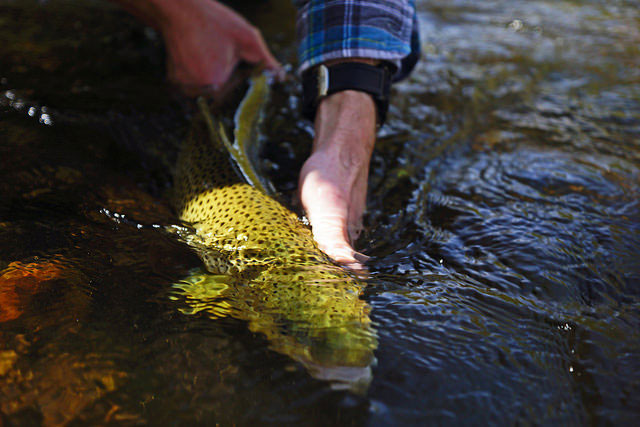The Life-Quality Balancing System

photo by Winged Reel
There is no off-season here in Colorado; rarely are there bad-weather days. It’s like living in the upbeat mind of an optimist: the sun always shines and the pint glass is always full, even when the bottom is cracked and leaking overly-hoppy beer. When people aren’t skiing they’re mountain biking, and when not on two-wheels they’re on foot, hoofing it up hills. Around those pesky nine-to-fives some of us have, they cross-train, stay-fit, and eat-right (at least when we’re looking).
It’s inspiring and sometimes ridiculous to watch (must we really jog-in-place at stoplights?), exhausting to be a part of. When there’s low gray clouds, veils of rain, fog piled up like a jellyroll deconstructing across the Bay—then it’s ok to sit inside, read, bake, eat what you baked, and marathon House of Cards. But not here, not now.
Here, there’s no off-season, no closed season for trout. There is no Opening Day. In the West we’re lucky: we’ve established native, reproducing populations of fish and aren’t entirely reliant on state hatchery trucks to pull up and dump thousands of eatable-sized rainbows smelling of dog food, bringing the stench of crowds.
We’ve engineering our closed season away with dams and tailwaters, with aptly named “toilet bowls” that never stop flushing, keeping the ice from forming except in the most severe of winters. Someone’s always got to go. Someone’s always got to drag nymphs through ice-rimmed pools because they want to and they can and so they do. Wouldn’t you?
Silly question.
Even when the bass are bunked down, the carp slow and indifferent, and the highcountry trout streams still covered with ice and feet of snow (technically “open,” if you could get down to them), there are trout ready and willing in this state’s streams, able to take your mind off your worries and cares, to make you feel special. That sounds like some messed up ad for an inter-species escort service, doesn’t it?
I know.
Shortly after I started fly fishing I was given David James Duncan’s book The River Why for Christmas, tied up in a brown paper wine bag with a bow from someone who doesn’t usually celebrate the day. That’s to say, it meant a lot. And like my dog into road apples I dove excitedly in—its crisp pages now creased, coffee-stained, underlined in both pencil and pen.
Like Colorado, Gus Orviston—the novel’s main character and narrator—didn’t want an off-season. Taking it further, he didn’t want a single off-day and thus orchestrated what he imagined to be an Ideal Schedule, the result of “quasi-logistical gymnastics” his “polarized brain was wont to perform.”
The foundation of this Ideal Schedule was Gus’s devised Life-Quality Balancing System (L.Q.B.S.). Minutes of the day represented by fishhooks (size 8, medium-shanked), divided into three: Neutral Minutes (N.M.), Unsatisfactory Minutes (U.M.), and Satisfactory Minutes (S.M.). The U.M.s cast to the left scale-pan, like cursed goats into fire. And the S.M.s weighed and measured on the right, not found wanting in anything but their number. The chosen ones, righteous in purpose, holy unto all waters. N.M.s were kept out of the conflict like The Vatican, in a small cardboard box like a coffin.
By whittling away school, family, friends (anglers and non), eating, housework (“dust not unhealthy,” he jotted down on his angler-ascetic’s list). The result, he figured, would be a nirvanic state of “U.S.A.” (Unending Satisfaction Actualization). Meaning 14 ½ hours of fishing time per day. Meaning… bliss.
But Gus comes to find out that somewhere in all of his sums and weighing and measuring, he went wrong. He left out something important: anticipation. “The once-monthly fisherman adores his rare day on the river, imagining that ten times the trips would yield ten times the pleasure,” he says. “But I have lived the gallant fisher’s life, and I learned that not fishing is crucial to the enjoyment of fishing.” In other words, too much of a good thing isn’t a good thing anymore. It’s just work.
Whether you trace it back to our species’ evolution and adaptation to change—that we can get used to just about anything but are at the same time never satisfied with what we have, even when it’s decadent and good—the curiosity that killed the cat keeps us going, got us walking upright and out of the cave. That sort of thing. Or, whether it’s the simple truth that if you eat ice cream every night it loses a bit of its sweetness. We become habituated, cease to respond to stimulus. Sometimes that’s what keeps us alive; sometimes, it’s what makes us give up.
Lately I’ve been itching for summer, for long and light evenings, treeline, and parr-marked trout. For not so many logs piled into the woodstove and a garden that won’t grow but that I’ll plant anyway. I’ve been thinking about Duncan’s novel, and realized: somewhere along the way I’ve worked out my own Perfect Schedule—my own off-season and opening day (which doesn’t involve trout at all, but rather still-cool warmwaters with grumpy bass and ambivalent carp). I’ve created my own L.Q.B.S.—that’s to say, I take a few winter months to not fish—and discovered that Gus is right: sometimes love is in the breaks, gallantry in restraint, appreciation in the wait. Enjoyment holes up in the spaces in between seasons where you get short of breath anticipating more.











